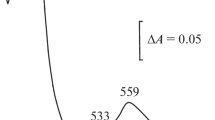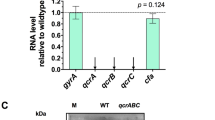Abstract
Desulfobacter postgatei grows on acetate and sulfate as energy source. The oxidation of acetate to 2 CO2 proceeds via the citric acid cycle involving membrane-bound succinate dehydrogenase and membrane-bound malate dehydrogenase. We report here that the organism contains membrane-bound NADPH dehydrogenase and ferredoxin: NADP oxidoreductase for the reoxidation of NADPH and reduced ferredoxin generated during isocitrate- and 2-oxoglutarate oxidation, respectively. The presence of proton translocating ATPase activity is also described.
NADPH dehydrogenase and succinate dehydrogenase were found to be electrically connected within the membrane and electron transfer between these two enzymes was shown to be coupled with proton translocation. The membrane fraction catalyzed the oxidation of NADPH with fumarate and the reduction of NADP with succinate. NADPH oxidation with fumarate was stimulated by protonophores and inhibited by the proton translocating ATPase inhibitor dicyclohexylcarbodiimide (DCCD) and by heptylhydroxyquinoline-N-oxide (HQNO); inhibition by DCCD was relieved by protonophores. NADP reduction with succinate was dependent on ATP and inhibited by protonophores, DCCD, and HQNO. The membrane fraction also mediated the oxidation of NADPH with the water soluble menaquinone analogue dimethylnaphthoquinone (DMN) and the reduction of fumarate with DMNH2. Only the former reaction was stimulated by protonophores and only the latter reaction was inhibited by HQNO. This suggests that the NADPH dehydrogenase reaction is the site of energy conservation and the succinate dehydrogenase is the site of HQNO inhibition.
Similar content being viewed by others
Abbreviations
- APS:
-
Adenosine 5′-phosphosulfate
- DCCD:
-
N,N′-dicyclohexylcarbodiimide
- DCPIP:
-
2,6-dichloroindophenol
- DMN:
-
2,3-dimethyl-1,4-naphthoquinone
- DTT:
-
DL-1,4-dithiothreitol
- HQNO:
-
2(n-heptyl)-4-hydroxyquinoline-N-oxide
- TCS:
-
3,5,3′,4′-tetrachlorosalicylanilide
- Tricine:
-
N-tris-(hydroxymethyl)methylglycine
- TTFB:
-
4,5,6,7-tetrachloro-2′-trifluoromethylbenzimidazole
- SF-6847:
-
3,5-di-tert-butyl-4-hydroxybenzylidenemalononitrile
References
Bode CH, Goebell H, Stähler, E (1968) Zur Eliminierung von Trübungsfehlern bei der Eiweißbestimmung mit der Biuretmethode. Z Klin Chem Klin Biochem 5:419–422
Brandis-Heep A, Gebhardt NA, Thauer RK, Widdel F, Pfennig N (1983) Anaerobic acetate oxidation to CO2 by Desulfobacter postgatei. 1. Demonstration of all enzymes required for the operation of the citric acid cycle. Arch Microbiol 136:222–229
Clark WM (1972) Oxidation-reduction potentials of organic systems. Robert E. Krieger Publishing Company, Huntington, NY
Collins MD, Widdel F (1986) Respiratory quinones of sulphatereducing and sulphur-reducing bacteria: A systematic investigation. System Appl Microbiol 8:8–18
Erecińska M, Wilson DF (1981) Inhibitors of mitochondrial functions. Pergamon Press, Oxford New York Toronto Sydney Paris Frankfurt
Fuchs G, Länge S, Rude E, Schäfer S, Schauder R, Scholtz R, Stupperich E (1987) Autotrophic CO2 fixation in chemotrophic anaerobic bacteria. In: Van Verseveld HW, Duine JA (eds) Microbial growth on C1 compounds. Martinus Nijhoff Publishers, Dordrecht Boston Lancaster, pp 39–43
Gebhardt NA, Linder D, Thauer RK (1983) Anaerobic acetate oxidation to CO2 by Desulfobacter postgatei. 2. Evidence from 14C-labelling studies for the operation of the citric acid cycle. Arch Microbiol 136:230–233
Gebhardt NA, Thauer RK, Linder D, Kaulfers PM, Pfennig N (1985) Mechanism of acetate oxidation to CO2 with elemental sulfur in Desulfuromonas acetoxidans. Arch Microbiol 141: 392–398
Goldberg DM, Ellis G (1983) Isocitrate dehydrogenase. In: Bergmeyer HU (ed) Methods of enzymatic analysis, vol III. Verlag Chemie, Weinheim, pp 183–190
Hansen IA, Kremer DR (1988) Role of NAD(P)H in dissimilatory sulphate reduction. In: Soc Gen Microbiol, Abstracts booklet (110th meeting). University of Southampton, p 11
Hederstedt L, Rutberg L (1981) Succinate dehydrogenase — a comparative review. Microbiol Rev 45:542–555
Heytler, PG (1979) Uncouplers of oxidative phosphorylation. In: Fleischer S, Packer L (eds) Methods in enzymology, vol LV. Academic Press, New York San Francisco London, pp 462–472
Ishimoto M, Fujimoto D (1961) Biochemical studies on sulfatereducing bacteria. X. Adenosine-5-phosphosulfate reductase. J Biochem 50:299–304
Jones CW (1977) Aerobic respiratory systems in bacteria. In: Haddock BA, Hamilton WA (eds) Microbial energetics. Cambridge University Press, Cambridge London New York Melbourne, pp 23–59
Jones HE, Skyring GW (1975) Effect of enzymic assay conditions on sulfite reduction catalysed by desulfoviridin from Desulfovibrio gigas. Biochim Biophys Acta 377:52–60
Kerscher L, Oesterhelt D (1981) The catalytic mechanism of 2-oxoacid: ferredoxin oxidoreductase from Halobacterium halobium. Eur J Biochem 116:595–600
Kerscher L, Nowitzki S, Oesterhelt D (1982) Thermoacidophilic archaebacteria contain bacterial-type ferredoxins acting as electron acceptors of 2-oxoacid:ferredoxin oxidoreductases. Eur J Biochem 128:223–230
Kerscher L, Oesterhelt D, Cammack R, Hall DO (1976) A new plant-type ferredoxin from halobacteria. Eur J Biochem 71:101–107
Klingenberg M, Schollmeyer P (1960) Zur Reversibilität der oxydativen Phosphorylierung. Biochem Z 333:335–350
Kremer DR, Hansen TA (1988) Pathway of propionate degradation in Desulfobulbus propionicus. FEMS Microbiol Lett 49:273–277
Kremer DR, Veenhuis M, Fauque G, Hansen TA (1988) Immunocytochemical localization of APS reductase and bisulfite reductase in three Desulfovibrio strains. In: Soc Gen Microbiol, Abstracts booklets (110th meeting). University of Southampton, p 36
Kröger A, Unden G (1985) The function of menaquinone in bacterial electron transport. In: Lenaz G (ed) Coenzyme Q. John Wiley, Chichester, pp 285–300
Kröger A, Schröder I, Paulsen J, Beilmann A (1988) Acetate oxidation with sulphur and sulphate as terminal electron acceptors. In: Cole JA, Ferguson SJ (eds) The nitrogen and sulphur cycles. Cambridge University Press, Cambridge New York New Rochelle Melbourne Sydney, pp 133–145
Kröger A, Winkler E, Innerhofer A, Hackenberg H, Schägger H (1979) The formate dehydrogenase involved in electron transport from formate to fumarate in Vibrio succinogenes. Eur J Biochem 94:465–475
Kruber O (1929) Über das 2,3-Dimethyl-naphthalin im Steinkohlenteer. Ber Deutsche Chem Ges, pp 3044–3046
Kurokawa T, Fukumori Y, Yamanaka T (1987) Purification of a flavoprotein having NADPH-cytochrome c reductase and transhydrogenase activities from Nitrobacter winogradskyi and its molecular and enzymatic properties. Arch Microbiol 148:95–99
Lee JP, Yi CS, LeGall J, Peck HD Jr (1973) Isolation of a new pigment, desulforubidin, from Desulfovibrio desulfuricans (Norway strain) and its role in sulfite reduction. J Bacteriol 115:453–455
Möller D, Schauder R, Fuchs G, Thauer RK (1987) Acetate oxidation to CO2 via a citric acid cycle involving an ATP-citrate lyase: a mechanism for the synthesis of ATP via substrate level phosphorylation in Desulfobacter postgatei growing on acetate and sulfate. Arch Microbiol 148:202–207
Odom JM, Peck HD Jr (1984) Hydrogenase, electron-transfer proteins, and energy coupling in the sulfate-reducing bacteria Desulfovibrio. Annu Rev Microbiol 38:551–592
Paulsen J, Kröger A, Thauer RK (1986) ATP-driven succinate oxidation in the catabolism of Desulfuromonas acetoxidans. Arch Microbiol 144:78–83
Peck HD Jr, Lissolo T (1988) Assimilatory and dissimilatory sulphate reduction: Enzymology and bioenergetics. In: Cole JA, Ferguson SJ (eds) The nitrogen and sulphur cycles. Cambridge University Press, Cambridge New York New Rochelle Melbourne Sydney, pp 99–132
Pfennig N, Widdel F, Trüper HG (1981) The dissimilatory sulfatereducing bacteria. In: Starr MP et al. (eds) The prokaryotes. Springer, Berlin Heidelberg New York, pp 926–940
Postgate JR (1984) The sulphate reducing bacteria, 2nd edn. Cambridge University Press, Cambridge
Samain E, Patil DS, DerVartanian DV, Albagnac G, LeGall J (1987) Isolation of succinate dehydrogenase from Desulfobulbus elongatus, a propionate oxidizing, sulfate reducing bacterium. FEBS Lett 216:140–144
Schauder R, Eikmanns B, Thauer RK, Widdel F, Fuchs G (1986) Acetate oxidation to CO2 in anaerobic bacteria via a novel pathway not involving reactions of the citric acid cycle. Arch Microbiol 145:162–172
Schauder R, Widdel F, Fuchs G (1987) Carbon assimilation pathways in sulfate-reducing bacteria. II. Enzymes of a reductive citric acid cycle in the autotrophic Desulfobacter hydrogenophilus. Arch Microbiol 148:218–225
Schneider E, Altendorf K (1987) Bacterial adenosine 5′-triphosphate synthase (F 1 F 0): Purification and reconstitution of F 0 complexes and biochemical and functional characterization of their subunits. Microbiol Rev 51:477–497
Schönheit P, Wäscher C, Thauer RK (1978) A rapid procedure for the purification of ferredoxin from Clostridia using polyethyleneimine. FEBS Lett 89:219–222
Solioz M (1984) Dicyclohexylcarbodiimide as a probe for proton translocating enzymes. TIBS 9:309–312
Stams AJM, Kremer DR, Nicolay K, Weenk GH, Hansen TA (1984) Pathway of propionate formation in Desulfobulbus propionicus. Arch Microbiol 139:167–173
Stiggall DL, Galante YM, Hatefi Y (1979) Preparation and properties of complex V. In: Fleischer S, Packer L (eds) Methods in enzymology, vol LV. Academic Press, New York San Francisco London, pp 308–315
Stille W, Trüper HG (1984) Adenylylsulfate reductase in some new sulfate-reducing bacteria. Arch Microbiol 137:145–150
Thauer RK (1972) CO2-reduction to formate by NADPH. The initial step in the total synthesis of acetate from CO2 in Clostridium thermoaceticum. FEBS Lett 27:111–115
Thauer RK (1982) Dissimilatory sulphate reduction with acetate as electron donor. Phil Trans R Soc Lond B 298:467–471
Thauer RK, Badziong W (1980) Respiration with sulfate as electron acceptor. In: Knowles CJ (ed) Diversity of bacterial respiratory systems, vol II. CRC Press Inc, Boca Raton, Florida, pp 66–85
Thauer RK, Morris JG (1984) Metabolism of chemotrophic anaerobes: Old views and new aspects. In: Kelly DP, Carr NG (eds) The microbe 1984. Part II. Prokaryotes and eukaryotes. Soc Gen Microbiol Symposium 36. Cambridge University Press, Cambridge, pp 123–168
Thauer RK, Rupprecht E, Ohrloff C, Jungermann K, Decker K (1971) Regulation of the reduced nicotinamide adenine dinucleotide phosphate-ferredoxin reductase system in Clostridium kluyveri. J Biol Chem 246:954–959
Thauer RK, Jungermann K, Decker K (1977) Energy conservation in chemotrophic anaerobic bacteria. Bacteriol Rev 41:100–180
Uyeda K, Rabinowitz JC (1971) Pyruvate-ferredoxin oxidoreductase. III. Purification and properties of the enzyme. J Biol Chem 246:3111–3119
Veeger C, DerVartanian DV, Zeylemaker WP (1969) Succinate dehydrogenase. In: Lowenstein JM (ed) Methods in enzymology, vol XIII. Academic Press, New York San Francisco London, pp 81–90
Vogel G, Steinhart R (1976) ATPase of Escherichia coli: Purification, dissociation, and reconstitution of the active complex from the isolated subunits. Biochemistry 15:208–216
Weitzman PDJ (1981) Unity and diversity in some bacterial citric acid-cycle enzymes. In: Rose AH, Morris JG (eds) Advances in microbial physiology. Academic Press, London New York toronto Sydney San Francisco, pp 185–244
Widdel F (1980) Anaerober Abbau von Fettsäuren und Benzoesäure durch neu isolierte Arten Sulfat-reduzierender Bakterien. Doctoral thesis, Göttingen
Widdel F (1988) Microbiology and ecology of sulfate- and sulfurreducing bacteria. In: Zehnder AJB (ed) Environmental microbiology of anaerobes, chapt 10. John Wiley, New York London (in press)
Widdel F, Pfennig N (1977) A new anaerobic, sporing, acetateoxidizing, sulfate-reducing bacterium, Desulfotomaculum (emend.) acetoxidans. Arch Microbiol 112:119–122
Widdel F, Pfennig, N (1981) Studies on dissimilatory sulfate-reducing bacteria that decompose fatty acids. I. Isolation of new sulfate-reducing bacteria enriched with acetate from saline environments. Description of Desulfobacter postgatei gen. nov., sp. nov. Arch Microbiol 129:395–400
Widdel F, Pfennig N (1984) Dissimilatory sulfate- or sulfur-reducing bacteria. In: Krieg NR, Holt JG (eds) Bergey's manual of systematic bacteriology, vol 1. Williams & Wilkins, Baltimore London
Author information
Authors and Affiliations
Rights and permissions
About this article
Cite this article
Möller-Zinkhan, D., Thauer, R.K. Membrane-bound NADPH dehydrogenase- and ferredoxin: NADP oxidoreductase activity involved in electron transport during acetate oxidation to CO2 in Desulfobacter postgatei . Arch. Microbiol. 150, 145–154 (1988). https://doi.org/10.1007/BF00425154
Received:
Accepted:
Issue Date:
DOI: https://doi.org/10.1007/BF00425154




